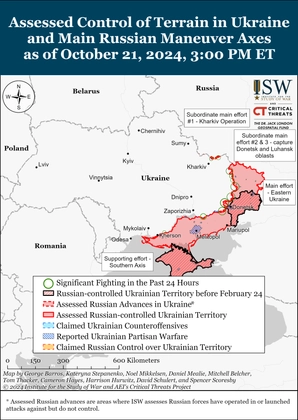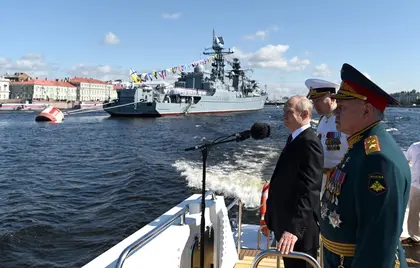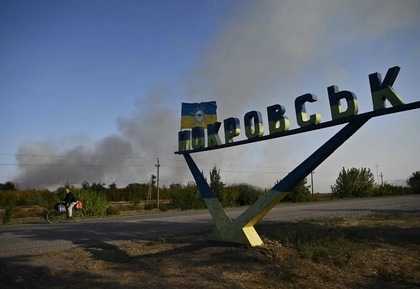In almost two years since launching its full-scale invasion, Russia has deployed weapons in Ukraine from every era dating back to the 1950s. Even though the war has not gone well for Moscow’s forces, the Russian army has still not used many of the weapons that Kremlin propaganda has trumpeted since Russian President Vladimir Putin came to power.
Putin opened his infamous Presidential Address to Russia’s Federal Assembly in Moscow on March 1, 2018, by saying:
JOIN US ON TELEGRAM
Follow our coverage of the war on the @Kyivpost_official.
“Today’s Address is a very special landmark event, just as the times we are living in, when the choices we make and every step we take, are set to shape the future of our country for decades to come.”
After spending most of his speech boasting how his government would be improving Russia’s economy, ending poverty, ensuring environmental protection, expanding medical care and so on, he moved on to what he said were the most important issues – Russia’s defenses.
He illustrated this part of his speech with a series of animations, that many commentators categorized as “cartoons.” They depicted his new miracle weapons including hypersonic intercontinental ballistic and air-to-ground missiles which would “render US missile defense meaningless.” He was to repeat the claims in 2021 and again when he said Russia had added sea-based hypersonic missiles to the menu of “wonder weapons.”

ISW Russian Offensive Campaign Assessment, October, 22, 2024
Kyiv Post takes a look at some of these so-called “wunderwaffe,” hoping to answer the fundamental question – why haven’t they appeared and, if they had, would they have made any difference?
BMPT-72 “Terminator 2” Tank fire support vehicle
BMPT-72 being demonstrated at the Russian army forum. Photo: ROSOBORONEXPORT publicity
While the BMPT-72 was encountered from the very start of Russia’s full-scale invasion of Ukraine, its limited availability has led to no noticeable impact on operations.
It came from a 1980s operational concept of having a separate combat vehicle armed with anti-tank weapons for use in urban areas. It has a crew of three and is mounted on a T-90 tank chassis with an unmanned turret fitted with two 30-mm cannons, Ataka anti-tank missile launchers, along with two AG-17D automatic grenade launchers on the hull.
Despite its name, many, including its users, feel it is no more effective than conventional armored combat vehicles such as the BMP-2 or BTR-82A, and has low mobility. While the chassis and crew are well-protected, the turret’s armament is protected only from small arms fire and small fragments. In addition, its fire control system is fairly rudimentary – especially compared with Western vehicles being fielded in Ukraine.
These limitations are such that only around a dozen had been fielded by the start of Russia’s “special military operation” with the 90th tank division and were seen during fighting around Severodonetsk in June and then fitted with anti-drone screens in attacks around Avdiivka in October. The screens were probably installed following the destruction of a BMPT-72 by what was described as a swarm of Ukrainian kamikaze drones in eastern Donetsk in August.
Kh-47M2 Kinzhal Missile
MIG-31K carrying Kinzhal missile. Photo: wikicommons
The Kinzhal (Dagger – NATO designation Killjoy) is a Russian missile declared as hypersonic – the accepted definition of which means one that flies more than five times the speed of sound. It is launched from modified MiG-31 fighter-interceptors or Tu-22M3M and Tu-160 strategic bombers.
In reality, it is not a true hypersonic missile as it only reaches hypersonic speed during the final part of its trajectory and can’t maneuver at such speeds while “cruising.”
During the initial stages of Russia’s full-scale invasion, Moscow claimed successful use of Kinzhals against Ukrainian targets on three occasions – in July 2022, December 2022, and in February 2023. The appearance of the American Patriot using Pac-3 missiles proved Putin’s invincibility claim was over-optimistic when a Dagger was shot down over Kyiv on May 4; then four more on May 16 following delivery of anti-aircraft missile systems to Ukraine.
Although Daggers are not as effective as Putin promised, they continue to pose a threat as Ukraine has a limited number of Patriot systems to combat them. On Aug. 11, Ukraine only managed to take out one of four Kinzhals, the rest hitting close to the Kolomyia airfield in the Ivano-Frankivsk region.
In a June report, the Yermak-McFaul Group identified that Kinzhal, as with many other Russian-made missiles, rely on foreign, mainly US components for their production of the rocket. In the middle of October, Putin announced that the Kinzhal-equipped Mig-31K would be deployed to patrol the Black Sea.
The “Armata” T-14 MBT
Armata T-14 tank at the 2016 Victory Parade, Moscow. Photo: wikicommon
In 2009, Russia announced the development of the Armata “armored vehicle universal platform” that would be the basis for its next generation of tanks, IFV engineering, repair and recovery equipment.
First off the production line would be the Armata T-14 main battle tank, with the Russian army scheduled to receive 2,300 of them between 2015 and 2020. By 2018, it was obvious that wasn’t going to happen and final delivery was scheduled for 2025.
Later that year, it was announced that serial production would begin in 2022, with delivery of 100 trial vehicles to the 2nd Guards Motor Rifle Division based in Kaniinets. In December 2021, the Russian state arms company Rostec stated it had started and “more than 40” Armata tanks would be delivered by the end of 2023.
The designers claimed it to be a whole new concept in tank manufacture. It would be equipped with a “network-centric’ communication system allowing instant data exchange between vehicles and units. It was fitted with combined steel and ceramic armor overlaid with continuous explosive reactive armor (ERA), and not add-on blocks as with current tanks.
Increased protection of the crew was provided by them being housed in an armored capsule separated from the turret. It was also fitted with the computerized “Afganit active protection system,” combining kinetic projectiles to supposedly shoot down incoming anti-tank missiles and EW systems that would disrupt their guidance systems.
Despite original plans to use the standard 125mm Russian main armament, reports suggested that it might be fitted with a new 152mm gun capable of firing new generations of tank shells and anti-tank missiles. New engines and gear boxes were also promised rather than mere upgrades of power packs from the T80 and T90 models.
The Armata T-14 was first seen by the Russian public during rehearsals for the 2015 May Day parade on Moscow’s Red Square – when it broke down and had to be towed away.
The Russian state news agency RIA Novosti claimed Armatas had been deployed to Ukraine in April 2023. However, in the intervening six months, none have been seen, perhaps because, as Putin once claimed, the tank would be invisible on the battlefield.
The Kurganets-25 armored fighting vehicles
Prototype B-10 AOC version of the Kurganets-25 at Russia’s 2022 army exhibition. Photo: Russian armed forces/open source
The Kurganets-25 is 25-ton mine-protected, tracked, amphibious, IFV fitted with remote-controlled cannon, modular upgradeable armor and the crew housed in a separate armored capsule. It was intended to replace all tracked IFV in service with the Russian military. Work began in 2010 with the first proof of concept vehicles shown during the same 2015 May Day rehearsals as the Armata tank, with the turret and main armament shrouded.
Serial production was supposed to begin in 2016, but in 2020 it was announced that there were certification issues and, by 2023, it was confirmed that further fundamental modifications would be necessary with a new delivery schedule no longer available.
For the first time, the public was allowed to look at a prototype of the B-10 armored personnel carrier (APC) variant of the vehicle at Russia’s 2022 Army exhibition.
2S35 Koalitsiya (Coalition) – SV
2S35 Koalitsiya seen at Moscow parade in 2015. Photo: screenshot from Russian media
The 2S35 Koalitsiya-SV is intended to be the successor to the 2S19 Msta-S and other ageing Russian 152 mm self-propelled artillery systems but incorporates many components from earlier systems.
It first appeared as an “over and under” twin barreled demonstrator in 2006, using the same chassis as the 2S19. It supposedly had fully automatic ammunition selection, as well as handling and loading systems which it gave it a high rate of fire of 16 rounds per minute.
This unique design was soon abandoned and a new, single gun prototype appeared in 2013 with a first batch of 12 being produced in 2014 and handed over to the military for evaluation the following year. It made its first public appearance at the 2015 Victory Day parade in Moscow.
These early prototypes had a number of technical problems and so it was not until three years later that the “finished article” was handed over. Russian military acceptance trials were programmed to be completed by 2022 but were held up by the full-scale invasion of Ukraine and the imposition of Western sanctions.
Although the Koalitsiya visibly resembles the older 2S19, it is a totally different artillery system. Its turret is unmanned and uses a fully automated ammunition loading and handling system based on the original prototype.
The howitzer is said to use a modular charge system, allowing it to fire a wide range of ammunition, including standard high explosive and cluster rounds giving it a range of 30 km or 40 km with a rocket-assisted projectile (RAP).
Rostec claims to have developed a new long-range precision-guided round which has a maximum range of 70 km and high level of accuracy.
The 2S43 Malva (type of flower)
2S43 Malva self-propelled artillery system. Photo: Military today / open source
Looking suspiciously similar to the French Caesar artillery system, the Malva is fitted with the same 152 mm gun as the 2S35 Koalitsiya-SV.
It is said to have a maximum range of only 24.5 km., which is less than both the 2S5 and 2S19 weapons it is slated to replace. There is currently no information on whether it will be provided with, or could use the extended range ammunition, available to the 2S35.
Its gun has limited traverse 30 degrees on each side, and only has armor on the crew’s cab. This means it only gives the crew protection against small arms fire and artillery shell splinters.
The 2020 prototype was only designed for manual gun loading, although it is believed that a load-assisting system will be provided with production models. It has a probable maximum rate of fire of up to seven rounds per minute and carries a total of 30 ready-to-use projectiles with associated charges. It can be used in direct fire mode.
Sukhoi Su-57 fighter aircraft
Sukhoi Su-57 Felon stealth fighter jet. Photo: wikicommon
The Su-57 (NATO designation Felon) is claimed to be a fifth-generation stealth fighter, on a par with the US F-22 and F-35. This designation has been queried by many. Its detractors say it does not meet the criteria for maneuverability, levels of supersonic speed, low visibility in the infrared and radar ranges, communications and data exchange capability, automatic flight control, target detection and acquisition.
The main area for criticism centers on its engine which is over 20 years old and the upgraded replacement has yet to be successfully proven.
Despite claims the aircraft have been deployed to Syria and Ukraine, the fielded versions are nowhere near the fifth-generation marker.
The first contract was for the supply of 76 Su-57 fighters for the Russian Aerospace Forces in 2019 but, when the first production aircraft crashed, delivery of the first aircraft was delayed until late 2020. With the full-scale invasion of Ukraine Sukhoi claimed to have stepped up production but, even so, it is likely that only around 20 will be delivered by the end of 2024.
It is understood that the Su-57 has been retrofitted with a long-range cruise missile which shows that, in spite of its supposed stealth capability, Russia is reluctant to deploy it into areas reachable by Ukrainian air defense.
You can also highlight the text and press Ctrl + Enter













